《电子商务导论》
- 格式:doc
- 大小:123.00 KB
- 文档页数:13
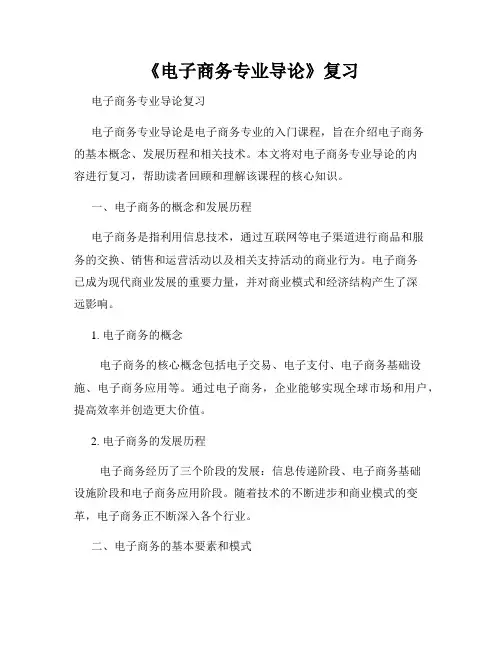
《电子商务专业导论》复习电子商务专业导论复习电子商务专业导论是电子商务专业的入门课程,旨在介绍电子商务的基本概念、发展历程和相关技术。
本文将对电子商务专业导论的内容进行复习,帮助读者回顾和理解该课程的核心知识。
一、电子商务的概念和发展历程电子商务是指利用信息技术,通过互联网等电子渠道进行商品和服务的交换、销售和运营活动以及相关支持活动的商业行为。
电子商务已成为现代商业发展的重要力量,并对商业模式和经济结构产生了深远影响。
1. 电子商务的概念电子商务的核心概念包括电子交易、电子支付、电子商务基础设施、电子商务应用等。
通过电子商务,企业能够实现全球市场和用户,提高效率并创造更大价值。
2. 电子商务的发展历程电子商务经历了三个阶段的发展:信息传递阶段、电子商务基础设施阶段和电子商务应用阶段。
随着技术的不断进步和商业模式的变革,电子商务正不断深入各个行业。
二、电子商务的基本要素和模式电子商务的基本要素包括电子商务基础设施、电子商务应用、电子商务模式和电子商务平台。
其中,电子商务模式是实现商业运作的基本框架,决定了商业活动的核心逻辑。
1. 电子商务基础设施电子商务基础设施包括硬件设备、软件系统、网络通信和数据安全等。
它们构成了电子商务的技术基础,保障了电子商务系统的安全和可靠运行。
2. 电子商务应用电子商务应用包括电子市场、电子商城、电子支付、供应链管理等。
通过这些应用,企业和消费者可以实现在线购物、在线支付、在线客服等功能。
3. 电子商务模式电子商务模式是商业活动的基本逻辑和组织形式,包括B2B(企业对企业)、B2C(企业对消费者)、C2C(消费者对消费者)等。
每种模式都有自己的特点和应用场景。
4. 电子商务平台电子商务平台是连接买卖双方的中介平台,具有信息交流、交易撮合和支付结算等功能。
著名的电子商务平台包括阿里巴巴、京东、亚马逊等。
三、电子商务的关键技术和发展趋势电子商务的发展和创新离不开关键技术的支撑,并受到市场需求和社会环境等因素的影响。
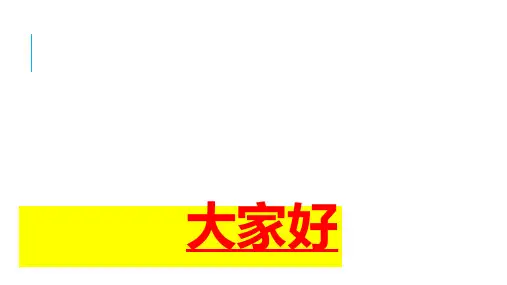
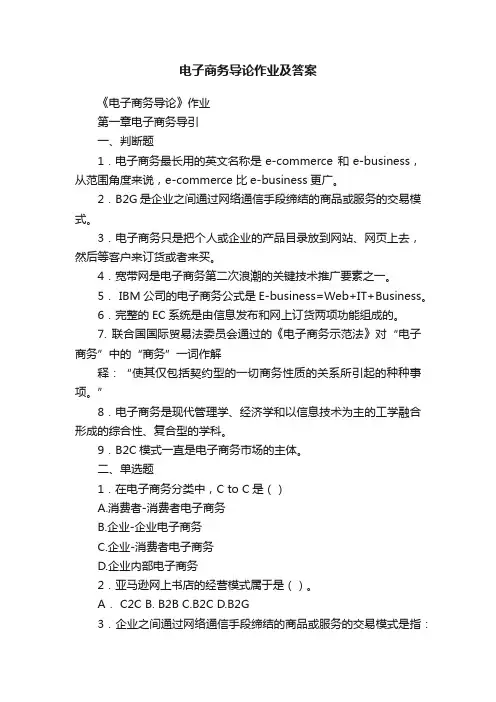
电子商务导论作业及答案《电子商务导论》作业第一章电子商务导引一、判断题1.电子商务最长用的英文名称是e-commerce 和e-business,从范围角度来说,e-commerce 比e-business更广。
2.B2G是企业之间通过网络通信手段缔结的商品或服务的交易模式。
3.电子商务只是把个人或企业的产品目录放到网站、网页上去,然后等客户来订货或者来买。
4.宽带网是电子商务第二次浪潮的关键技术推广要素之一。
5. IBM公司的电子商务公式是E-business=Web+IT+Business。
6.完整的EC系统是由信息发布和网上订货两项功能组成的。
7. 联合国国际贸易法委员会通过的《电子商务示范法》对“电子商务”中的“商务”一词作解释:“使其仅包括契约型的一切商务性质的关系所引起的种种事项。
”8.电子商务是现代管理学、经济学和以信息技术为主的工学融合形成的综合性、复合型的学科。
9.B2C模式一直是电子商务市场的主体。
二、单选题1.在电子商务分类中,C to C是()A.消费者-消费者电子商务B.企业-企业电子商务C.企业-消费者电子商务D.企业内部电子商务2.亚马逊网上书店的经营模式属于是()。
A. C2C B. B2B C.B2C D.B2G3.企业之间通过网络通信手段缔结的商品或服务的交易模式是指:A. C2C B. B2B C.B2C D.B2G4.个人之间通过网络通信手段缔结的商品或服务的交易模式是指:A. C2C B. B2B C.B2C D.B2G5.某公司通过网络平台帮助个人将产品出售给其他个人,并对每一笔交易收取一小笔佣金。
这属于()模式。
A.B2C B.B2B C.C2C D.P2P6.从传统商务到电子商务的形成大致经历了3个阶段,依次是:A.商业综合业务数字化、商业电子化、电子商业系统B.商业综合业务数字化、电子商业系统、商业电子化C.商业电子化、电子商业系统、商业综合业务数字化D.商业电子化、商业综合业务数字化、电子商业系统7.目前,在电子商务的几种模式中,()占市场的主体。
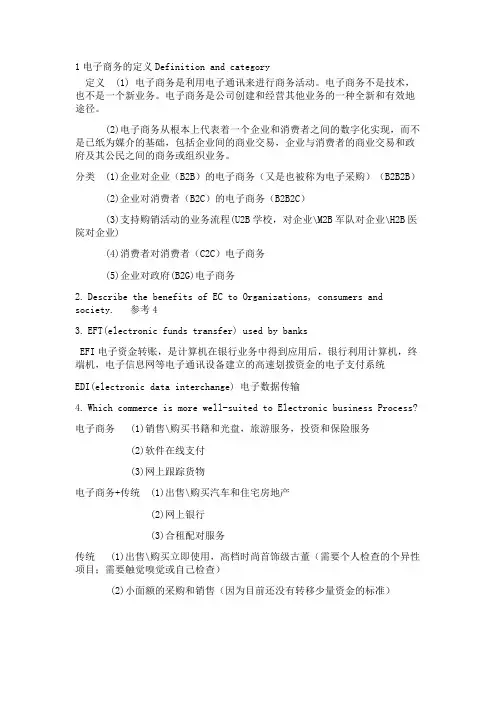
1电子商务的定义Definition and category定义 (1) 电子商务是利用电子通讯来进行商务活动。
电子商务不是技术,也不是一个新业务。
电子商务是公司创建和经营其他业务的一种全新和有效地途径。
(2)电子商务从根本上代表着一个企业和消费者之间的数字化实现,而不是已纸为媒介的基础,包括企业间的商业交易,企业与消费者的商业交易和政府及其公民之间的商务或组织业务。
分类 (1)企业对企业(B2B)的电子商务(又是也被称为电子采购)(B2B2B)(2)企业对消费者(B2C)的电子商务(B2B2C)(3)支持购销活动的业务流程(U2B学校,对企业\M2B军队对企业\H2B医院对企业)(4)消费者对消费者(C2C)电子商务(5)企业对政府(B2G)电子商务2.Describe the benefits of EC to Organizations, consumers and society. 参考43.EFT(electronic funds transfer) used by banksEFI电子资金转账,是计算机在银行业务中得到应用后,银行利用计算机,终端机,电子信息网等电子通讯设备建立的高速划拨资金的电子支付系统EDI(electronic data interchange) 电子数据传输4.Which commerce is more well-suited to Electronic business Process?电子商务 (1)销售\购买书籍和光盘,旅游服务,投资和保险服务(2)软件在线支付(3)网上跟踪货物电子商务+传统 (1)出售\购买汽车和住宅房地产(2)网上银行(3)合租配对服务传统 (1)出售\购买立即使用,高档时尚首饰级古董(需要个人检查的个异性项目;需要触觉嗅觉或自己检查)(2)小面额的采购和销售(因为目前还没有转移少量资金的标准)5.Advantages of E-Commerce?(1)增加销售,降低成本使得小企业获得全球客户群通过电子销售查询,报价和订单受理降低成本(2)为买家提供采购机会(企业可以找出新的供应商和合作伙伴)(3)增加信息交换的速度和准确性,从而降低成本(4)可以每天24小时处理业务(5)购买信息的详细程度由用户选择(6)数字化商品可以立即交付(7)在互联网上分发可以降低退税。


第五章1、概念题(1)什么是电子结算系统?答:、(广义)电子结算就是买主和卖主之间的在线资金交换。
交换的内容通常是由银行发行的并由法定货币支撑的数字金融工具。
(2)什么是电子现金?有什么特点?支付机制如何?答:电子现金又称为数字现金,是一种以数据形式流通的货币,它把现金数值转换为一系列的加密序列数,通过这些序列数来表示显示中的各种金额的币值。
支付机制:目前还存在的问题:只有少数商家接受电子现金,而且只有少数几家银行提供电子现金开户服务,而且成本较高。
存在货币兑换问题,风险较大。
(3)什么是电子支票?有什么特点?支付机制如何?特点:(1)电子支票与纸质支票工作方法几乎相同,易于理解和接受;(2)加密的电子支票使它们比基于公共密钥加密的数字现金更易于流通,买卖双方的银行只要用公共密钥认证确认即可;(3)电子支票适用于各种市场,可以很容易地与EDI应用结合,推动EDI基础上的电子订货和电子支付;(4)第三方金融服务者不仅可以从交易双方处抽取固定交易费或按一定比列抽取费用,还可以作为银行身份提供存款项目,且电子支票存款账户很可能是无利率的,因此可以给第三方金融机构带来收益;(5)电子支付技术将公共网络进入连入支付和银行清算网络。
(4) 什么是电子信用卡?有什么特点?支付机制如何?答:电子信用卡是一种支付方式。
特点:具有制造成本低,信息保存可靠性高,开发方便,应用灵活和小型化等特点,电子信用卡与电子信用卡机——小型专用微机相配套,可广泛应用于各种有价证券、无价证券、信用证明等场合,亦可用于一些分散系统的数据信息、采集电子商务活动中使用的信用卡是电子信用卡,电子信用卡通过网络直接支付。
电子信用卡具有快捷,方便的特点,买方可以及时通过发卡机构了解持卡人的信用度,避免了欺诈行为的发生。
由于使用电子信用卡需要通过公共Internet的网络进行信用卡传输,因此在技术上需要保证传输的安全性和可靠性。
利用SET安全电子交易协议保证电子信用卡卡号和密码的安全传输,在信用卡进行支付的过程中,也需要认证客户·商家以及信用卡发放机构的身份,防止抵赖行为的发生。
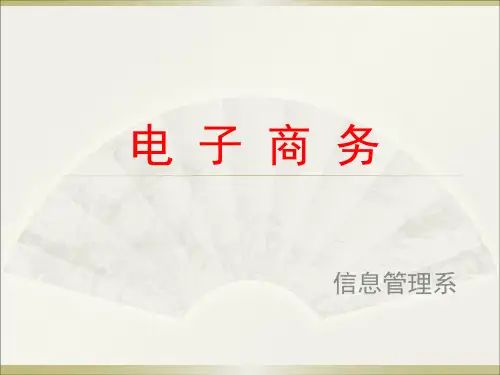
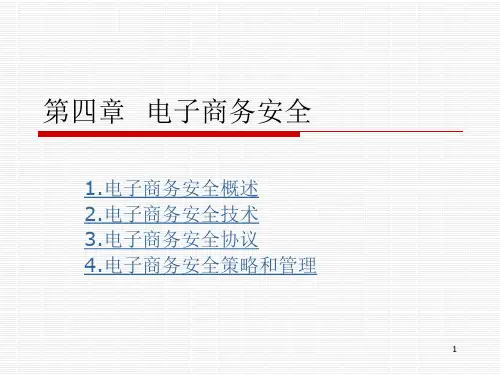

电子商务导论第二版课程设计一、课程背景随着信息技术的高速发展,电子商务迅速崛起并渗透到了我们生活中的各个方面。
电子商务可以为企业创造更多的商业机会,为消费者提供更多的方便和选择,成为推动社会经济发展的新引擎。
电子商务作为一门学科,学生需要一定的专业知识才能适应这个新的商业模式。
因此,我们开设了这门《电子商务导论》课程,旨在培养学生对电子商务的基本概念、理论体系和应用实践的全面认识。
本课程旨在让学生:•掌握电子商务的发展历程、概念、基础理论和主要应用领域。
•掌握电子商务平台、应用系统、网站设计和运营的方法和技能。
•了解电子商务的法律法规、商业模式、安全与风险管理、社会文化等方面的知识。
二、教学内容本课程主要分为四个部分:第一部分:电子商务概论•电子商务的概念、内涵、特点、发展历程和基本理论。
•电子商务的主要应用领域和应用模式。
•电子商务与传统商务的比较和联系。
第二部分:电子商务技术•电子商务平台的搭建和开发。
•电子商务应用系统的设计和开发。
•电子商务网站的设计和运营。
第三部分:电子商务管理•电子商务的战略规划和企业实践。
•电子商务供应链管理和客户关系管理。
•电子商务的财务管理、安全与风险管理以及法律法规等方面的管理。
第四部分:电子商务案例分析•案例分析,包括国内外优秀电子商务企业的成功案例,以及电子商务领域的经典案例。
对案例进行解读和讨论,提炼出电子商务的成功要素和经验。
三、教学方法本课程采用讲授、案例分析、小组讨论、实践操作等多种教学方法,其中:•讲授:教师通过PPT课件、教材、文献资料等方式向学生传授电子商务相关知识。
•案例分析:让学生通过对电子商务成功案例的分析,了解电子商务的成功因素和经验,培养学生综合分析和解决问题的能力。
•小组讨论:将学生分成小组,进行电子商务相关问题的讨论,促进学生间的交流和合作,提高学生的思维能力。
•实践操作:通过设计、开发、运营电子商务平台和网站等实际操作,让学生深入了解电子商务的实践应用,增强学生的实践能力和创新能力。

•电子商务概述•电子商务技术基础•电子商务市场分析•电子商务营销策略目录•电子商务物流管理•电子商务法律规范与道德问题01电子商务概述电子商务定义与特点电子商务定义电子商务特点电子商务发展历程电子商务未来趋势电子商务发展阶段电子商务起源阶段、电子商务阶段和全程电子商务阶段。
20世纪60年代,电子数据交换技术的出现为电子商务奠定了基础。
B2B模式企业与企业之间的电子商务模式,包括供应链管理、采购管理等。
B2C模式企业与消费者之间的电子商务模式,包括网络购物、在线支付等。
C2C模式消费者与消费者之间的电子商务模式,包括二手交易、拍卖等。
O2O模式线上与线下相结合的电子商务模式,包括团购、外卖等。
电子商务基本模式网上银行、网上证券、保险电子商务等。
金融行业旅游行业零售行业制造业在线旅游服务、酒店预订、机票预订等。
网络购物、移动支付、智能物流等。
供应链管理、产品销售、客户服务等。
电子商务应用领域02电子商务技术基础互联网概述网络协议与技术云计算与大数据移动互联网互联网技术电子商务网站概述网站目标分析、用户需求分析、内容规划、交互设计等。
网站规划与设计网站开发技术网站测试与维护01020403网站测试方法、性能测试、安全测试、网站维护和更新等。
电子商务网站的定义、分类和特点。
Web 前端开发技术、后端开发技术、数据库技术等。
电子商务网站建设电子商务支付系统电子支付概述网上支付系统电子支付安全支付系统风险与防范电子商务安全技术电子商务安全概述电子商务安全的重要性、主要威胁和应对策略。
网络安全技术防火墙技术、入侵检测技术、网络隔离技术等。
数据加密与VPN技术数据加密算法、VPN技术的原理和应用。
身份认证与访问控制身份认证技术、访问控制策略和实施方法等。
03电子商务市场分析交易规模不断扩大随着网络技术的不断发展和普及,电子商务市场交易规模逐年增长,成为全球经济发展的重要动力之一。
多元化业务模式涌现B2B、B2C、C2C等传统业务模式不断创新发展,同时O2O、社交电商、直播电商等新型业务模式也迅速崛起。

电子商务导论课件一、教学内容本节课的教学内容来自于电子商务导论教材的第一章,主要内容包括电子商务的基本概念、电子商务的产生与发展、电子商务的框架结构以及电子商务的分类。
二、教学目标1. 使学生了解电子商务的基本概念,理解电子商务的产生与发展过程。
2. 帮助学生掌握电子商务的框架结构,明白电子商务的分类。
3. 培养学生对电子商务的兴趣,激发学生进一步学习电子商务的热情。
三、教学难点与重点重点:电子商务的基本概念、电子商务的产生与发展、电子商务的框架结构、电子商务的分类。
难点:电子商务的框架结构、电子商务的分类。
四、教具与学具准备教具:多媒体课件、黑板、粉笔。
学具:课本、笔记本、文具。
五、教学过程1. 实践情景引入:以淘宝网购物的场景引入,让学生思考网络购物的背后涉及到哪些电子商务的知识。
2. 知识讲解:讲解电子商务的基本概念,使学生了解电子商务的定义和特点。
3. 案例分析:分析电子商务的产生与发展过程,使学生明白电子商务的发展历程和趋势。
4. 框架结构讲解:讲解电子商务的框架结构,使学生了解电子商务的各个组成部分及其关系。
5. 分类讲解:讲解电子商务的分类,使学生明白电子商务的不同类型及其应用。
6. 随堂练习:针对讲解的内容,设计一些练习题,让学生当场练习,巩固所学知识。
7. 例题讲解:以具体的电子商务案例为例,讲解电子商务的应用和实践。
六、板书设计电子商务的基本概念电子商务的产生与发展电子商务的框架结构电子商务的分类七、作业设计1. 请简述电子商务的基本概念。
答案:电子商务是指利用计算机技术、网络通信技术和数据库技术,实现商务活动的一种新型商业模式。
2. 请描述电子商务的产生与发展过程。
答案:电子商务的产生与发展经历了从简单的信息发布到在线交易的过程,随着互联网技术的不断发展,电子商务逐渐成为人们日常生活和经济活动的重要组成部分。
3. 请阐述电子商务的框架结构。
答案:电子商务的框架结构包括:网络基础设施、安全体系、支付体系、物流体系、商务应用。
Chapter 1 Overview of Electronic Commerce1.1 True/False1) Every company needs a business model describing how the company operates, how it generates sales, and how it provides value to the customers and eventually profit to its owners.Answer: TRUE2) The terms e-commerce and e-business can be used interchangeably.Answer: TRUE3) The form EC takes depends on the degree of digitization of the product sold, the process, and the delivery method.Answer: TRUE4) In order for a situation to be considered as electronic commerce, the product, process, and delivery method should all be digital.Answer: FALSE5) Purchasing a computer from Dell's Web site is partial EC because the merchandise is physically delivered. Answer: TRUE6) Amazon. can be classified as a click-and-mortar organization.Answer: TRUE7) Pure-play organizations are old-economy organizations that perform their primary business offline, selling physical products by means of physical agents.Answer: FALSE8) According to Mockler, over 85 percent of EC volume is B2B.Answer: TRUE9) Transactions conducted on Priceline. are examples of collaborative commerce.Answer: FALSE10) The introduction of the World Wide Web was a major milestone in electronic commerce development. Answer: TRUE11) Online publishing is an electronic commerce application.Answer: TRUE12) A person purchasing a pair of shoes from Zappos is an example of B2B.Answer: FALSE13) Economic, legal, societal, and technological factors have created a highly competitive business environment in which customers are becoming less powerful.Answer: FALSE14) Business models are a subset of a business plan or business case and refer to methods of doing business by which a company can generate revenue.Answer: TRUE15) The structure of a social network is often very simple.Answer: FALSE1.2 Multiple Choice1) The process of buying, selling, or exchanging products,s, or information via the computer best definesA) electronic collaboration. B) electronic commerce.C) Tweeting. D) cyber sales.Answer: B2) A broader definition of EC that includes not just the buying and selling of goods ands, but also servicing customers, collaborating with business partners, and conducting electronic transactions within an organizationbest definesA) e-business. B) e-tailing.C) e-collaboration. D) cyber business.Answer: A3) EC can take several forms depending on the degree of digitization of the following three dimensions:A) the product or sold, the process, and the delivery method.B) the business process, the collaboration, and the transaction.C) the payment method, the delivery method, and the production method.D) the marketing channel, the agent, and the collaboration method.Answer: A4) Dell collaborating electronically with its partners and providing customer online is an example ofA) B2C. B) e-CRM.C) C2B. D) B2B2C.Answer: B5) Electronic commerce applications includeA) direct marketing. B) online banking.C) m-commerce. D) all of the above.Answer: D6) Support areas for EC include each of the following exceptA) infrastructure. B) people.C) public policy. D) business partnerships.Answer: A7) The e-commerce model in which all of the participants are businesses or other organizations is calledA) business-to-consumer. B) business-to-business.C) business-to-business-to-consumer. D) consumer-to-consumer.Answer: B8) The e-commerce model in which a business provides some product or to a client business that maintains its own customers is calledA) business-to-consumer. B) business-to-business.C) business-to-business-to-consumer. D) consumer-to-consumer.Answer: C9) Ebay auctions are mostlyA) business-to-employees. B) consumer-to-business.C) business-to-consumer. D) consumer-to-consumer.Answer: D10) The second generation of Internet-baseds that lets people collaborate and share information online in new ways, such as social networking sites, wikis, communication tools, and folksonomies best definesA) Wii. B) Web 2.0. C) EC 2.0. D) SNS2.Answer: B11) Using Web 2.0 tools, companies canA) encourage consumers to rate and comment on products.B) allow consumers to create their own topic areas and build communities.C) provide incentives such as sweepstakes and contests for customers to get involved in new product or design and marketing campaigns.D) do all of the above.Answer: D12) A ________ is a company's method of doing business to generate revenue to sustain itself.A) marketing strategy B) business modelC) value chain D) business planAnswer: B13) According to the ________ revenue model, customers pay a fixed amount, usually monthly, to receive some type of.A) subscription fees B) transaction feesC) advertising fees D) affiliate feesAnswer: A14) Which of the following is not a major revenue model?A) attributive fee B) salesC) transaction fees D) subscription feesAnswer: A15) Large private organizational buyers and government agencies make large-volume or large-value purchasesthrough ________, also known as reverse auctions.A) electronic tendering systems B) online direct marketingC) name-your-own-price models D) viral marketingAnswer: A1.3 Fill in the Blank1) ________ is the process of buying, selling, transferring, or exchanging products,s, and/or information viacomputer.Answer: Electronic commerce2) ________ are organizations that conduct some e-commerce activities, usually as an additional marketingchannel.Answer: Click-and-mortar organizations3) ________ describes the hardware, software, and networks used in EC.Answer: Infrastructure4) The e-commerce category that includes all internal organizational activities that involve the exchange ofgoods,s, or information among various units and individuals in an organization is ________.Answer: intrabusiness EC5) ________ is the e-commerce model in which individuals or groups communicate or collaborate online. Answer: Collaborative commerce6) A ________ is a that builds online communities by providing an online space for people to build freehomepages and that provides basic communication and support tools for conducting different activities in thesocial network.Answer: social network7) An ________ is a network that uses the Internet to link multiple intranets.Answer: extranet8) ________ is a broader definition of EC that includes not just the buying and selling of goods ands, but alsoservicing customers, collaborating with business partners, and conducting electronic transactions within an organization.Answer: E-businessDiff: 3 Page Ref: 289) A method of doing business by which a company can generate revenue to sustain itself defines ________. Answer: business model10) A ________ is a model in which a buyer requests would-be sellers to submit bids; the lowest bidder wins.Answer: tendering (bidding) system1.4 Essay1) List and briefly explain three of the five supports in the electronic commerce framework.Answer: The five supports are people, public policy, marketing and advertisement, supports, and businesspartnerships. The people pillar includes buyers, sellers, intermediaries,, information systems people, andmanagement. The public policy pillar includes taxes, legal, privacy issues, regulations, compliance, andtechnical standards. The marketing and advertisement pillar includes market research, promotions, web content,and targeted marketing. The supports pillar includes order fulfillment, logistics, payments, content, and securitysystems development. The business partnerships pillar includes affiliate programs, joint ventures, exchanges,e-marketplaces, and consortia.2) 2) List the five typical EC business models.Answer: The five typical EC business models are online direct marketing, electronic tendering systems, electronic marketplaces and exchanges, viral marketing, and social networking and Web 2.0 tools.Chapter 2 E-Marketplaces: Mechanisms, Tools, and Impacts of E-Commerce2.1 True/False1) EC enablers include electronic markets, e-stores, and e-catalogs.Answer: TRUE2) Storefronts, malls, and portals are EC mechanisms that support the entertainment EC activity. Answer: FALSE3) The emergence of electronic marketplaces has resulted in lower information search costs for buyers and lower transaction and distribution costs for sellers.Answer: TRUE4) Although both marketplaces and marketspaces can sell physical products, the marketspace can also sell digital products.Answer: TRUE5) An intermediary is a third party that operates between sellers and buyers.Answer: TRUE6) Travelers using airline Web sites to book their flights directly without the use of travel agents is resulting in the reintermediation of travel agents.Answer: FALSE7) Electronic storefronts, Internet malls, and exchanges are major B2B e-marketplaces. Answer: FALSE8) Brokers and infomediaries are two types of online intermediaries.Answer: TRUE9) Search engines not only "search and match," but also have capabilities that can be used to perform routine tasks that require intelligence.Answer: FALSE10) An electronic shopping cart is an order-processing technology that allows customers to accumulate items they wish to buy while they continue to shop.Answer: TRUE11) Shopping carts for B2B are fairly simple, but a shopping cart for B2C may be more complex. Answer: FALSE12) An auction is a market mechanism that uses a competitive process by which a seller solicits consecutive bids from buyers or a buyer solicits bids from sellers.Answer: TRUE13) Auctions are based on dynamic pricing.Answer: TRUE14) Reverse auctions are bidding or tendering systems in which the buyer places an item for bid ona request for quote system; then potential suppliers bid on the job, with the price reducing sequentially, and the lowest bid wins.Answer: TRUE15) In the one buyer, many potential sellers dynamic pricing configuration, the sellers use a forward auction.Answer: FALSE2.2 Multiple Choice1) Electronic markets are the EC mechanism supporting theA) communicate, collaborate and learn EC activities.B) presence and delivery, find information, compare, and analyze EC activities.C) improve performance EC activities.D) entertainment EC activities.Answer: B2) Each of the following is a main function of traditional and electronic markets exceptA) matching buyers and sellers.B) facilitating the exchange of information, goods,s, and payments associated with market transactions.C) financing the transformation of raw materials into finished products.D) providing an institutional infrastructure, such as a legal and regulatory framework that enables the efficient functioning of the market.Answer: C3) Digital products have different cost curves than those of regular products because in digitizationA) most costs are variable, and fixed costs are low.B) most costs are fixed, and variable costs are very low.C) most costs are fixed, but variable costs are high.D) all costs are variable.Answer: B4) The portion of an e-seller's business through which customers interact, including the seller's portal, electronic catalogs, shopping cart, and payment gateway is theA) front end of the business.B) back end of the business.C) infrastructure for the business.D) intermediary in the business.Answer: A5) The elimination of various types of agents that mediate between buyers and sellers, such as travel and insurance agents, is referred to asA) automation.B) disintermediation.C) remediation.D) e-distribution.Answer: B6) Online markets that are owned and operated by a single company and that are either sell-side or buy-side are known asA) private e-marketplaces.B) commercial portals.C) e-malls.D) B2B marketplaces.Answer: A7) Public e-marketspaces areA) usually B2B markets.B) often owned by a third party or consortium.C) usually regulated by the government.D) all of the above.Answer: D8) Functionalities provided by EC merchant server software includeA) electronic catalogs.B) search engines.C) shopping carts.D) all of the above.Answer: D9) The presentation of product information in an electronic form and also serving as the backbone of most e-selling sites describesA) e-distributor.B) Kindle.C) e-magazine.D) electronic catalog.Answer: D10) Search tools that search the contents of a user's or organization's computer files, rather than searching the Internet areA) desktop search tools.B) enterprise search tools.C) search engine tools.D) host search tools.Answer: A11) A market mechanism that uses a competitive process in which a seller solicits consecutive bids from buyers or a buyer solicits bids from sellers best definesA) electronic shopping.B) request for proposal.C) auction.D) request for quotation.Answer: C12) The most common and traditional form of auctions in which one seller entertains bids from many buyers best describesA) forward auctions.B) reverse auctions.C) bidding auction systems.D) tendering systems.Answer: A13) The dynamic pricing configuration where the resulting price is determined by each party's bargaining power, supply and demand in the item's market, and possibly business environment factors best describesA) one buyer, one seller.B) one seller, many potential buyers.C) one buyer, many potential sellers.D) many sellers, many buyers.Answer: A14) All of the following are benefits of e-auctions to buyers except:A) can liquidate large quantities quickly.B) convenience of bidding anywhere and any time.C) opportunity to bargain.D) opportunities to find unique items.Answer: A15) Which of the following statements about bartering is false?A) It is the oldest method of trade.B) It is primarily done between individuals and private parties.C) The problem with bartering is that it is difficult to find trading partners.D) Intermediaries can be helpful, but they are expensive and very slow.Answer: B2.3 Fill in the Blank1) ________ refers to an online market, usually B2B, in which buyers and sellers exchange goods ors.Answer: E-marketplace2) A marketplace in which sellers and buyers exchange goods ands for money (or other goods ands), but do so electronically defines ________.Answer: marketspace3) ________ refers to the portion of an e-seller's business processes through which customers interact, including the seller's portal, electronic catalogs, a shopping cart, a search engine, and a payment gateway.Answer: Front end4) A private e-marketplace in which one company sells either standard and/or customized products to qualified companies defines ________.Answer: sell-side e-marketplace5) An ________ is an online shopping center where many online stores are located.Answer: e-mall6) ________ are electronic intermediaries that provide and/or control information flow in cyberspace, often aggregating information and selling it to others.Answer: Infomediaries7) A ________ is an auction in which a seller entertains bids from buyers, and bidders increase the price sequentially.Answer: forward auction8) The ________ is an auction in which the buyer places an item for bid on a request for quote system, potential suppliers bid on the job, with the price reducing sequentially, and the lowest bid wins.Answer: reverse auction9) The ________ is an auction model in which a would-be buyer specifies the price he or she is willing to pay to any willing and able seller.Answer: name-your-own-price model10) ________ is a marketplace in which an intermediary arranges barter transactions. Answer: Bartering exchange2.4 Essay1) List the six major EC trading activity categories.Answer: The six major EC trading activity categories are: (1) presence and discovery, find information, compare, analyze; (2) trading buy, sell, exchange; (3) communicate, collaborate, learn; (4) entertainment; (5) improve performance; and (6) other activities, recruit, customer.2) Discuss intermediation, disintermediation, and reintermediation.Answer: Intermediation occurs when a third party operates between buyers and sellers. Intermediaries provide information about demand, supply, prices, and requirements or they offer value-addeds. E-marketplaces, infomediaries and portals provide information for free or low cost, resulting in the disintermediation or elimination of the intermediary. Reintermediation occurs when the disintermediated entity takes on new intermediary roles.Chapter 3 Retailing in Electronic Commerce: Products and Services3.1 True/False1) The amount and percentage of goods ands sold on the Internet is increasing rapidly, despite the failure of many dot- companies.Answer: TRUE2) When comparing retailing to e-tailing, e-tailing has a lower cognitive shopping overhead due to easy-to-establish mutual trust.Answer: FALSE3) Commodities with standard specifications (e.g., books, CDs, airline tickets) are expected to facilitate higher sales volumes.Answer: TRUE4) A business model is a description of how an organization intends to generate revenue through its business operations.Answer: TRUE5) Marketing done online between any seller and buyer is indirect marketing.Answer: FALSE6) Direct marketers are firms that sell directly to consumers over the Internet without maintaininga physical sales channel.Answer: FALSE7) A click-and-mortar retailer is a combination of both the brick-and-mortar retailer and an online transactional Web site.Answer: TRUE8) Competition among online travel e-tailers is fierce, with low margins, little customer loyalty, and increasing commoditization of products ands.Answer: TRUE9) The electronic job market can create high turnover costs for employers by accelerating employees' movement to other jobs.Answer: TRUE10) When compared to the traditional job market, an advantage of the online job market is its long life cycle.Answer: TRUE11) An advantage of the electronic job market for job seekers is that they can assess their market value.Answer: TRUE12) Many insurance companies use a dual strategy, keeping human agents but also selling online. Answer: TRUE13) The major risk of online trading is security.Answer: TRUE14) Both online banks and click-and-mortar banks carry some risks and problems, especially in international banking, including hackers and liquidity risk.Answer: TRUE15) A major problem in B2C is the increasing rate of online fraud.Answer: TRUE3.2 Multiple Choice1) Each of the following describes retailing except:A) A retailer is a sales intermediary.B) Many manufacturers sell directly to consumers and through wholesalers and retailers.C) E-tailing makes it easier for a manufacturer to sell directly to customers by cutting out the intermediary.D) Companies that produce a larger number of products, such as Proctor & Gamble, do not need retailers for efficient distribution.Answer: D2) Retailers who sell over the Internet are calledA) cyber marketers.B) e-tailers.C) B2B commerce marketers.D) brick-and-mortar operations.Answer: B3) What is the primary advantage of catalog sales?A) Catalogs eliminate the constraints of space and time.B) Customers prefer catalog shopping to e-tailing.C) Catalogs increase interest in products that are then bought online.D) Products ands can both be sold via catalogs.Answer: A4) With all else being equal in the online environment, goods with any of the following product characteristics are expected to facilitate greater online sales except:A) relatively expensive items.B) high brand recognition.C) digitized format.D) frequently purchased items.Answer: A5) Dell's distribution strategy is best described asA) a brick-and-mortar strategy.B) a shared mall strategy.C) a click-and-mortar strategy.D) direct marketing from a manufacturer.Answer: D6) A marketer that uses to advertise to potential customers is called aA) market maker.B) transaction broker.C) content disseminator.D) viral marketer.Answer: D7) Each of the following is a revenue model for online independent travel agents exceptA) direct competition revenues.B) direct revenues from commissions.C) subscription or membership fees.D) revenue sharing fees.Answer: A8) Compared to the traditional job market, the online job marketA) has a shorter life cycle.B) is usually specialized and local in scope.C) tends to be less reliable.D) tends to be much less expensive.Answer: D9) Which of the following parties use the Internet job market?A) employers seeking employeesB) classified adsC) job agenciesD) all of the aboveAnswer: D10) Advantages of the electronic job market for employers include each of the following exceptA) charging online processing fees.B) providing greater equal opportunity for job seekers.C) learning how to use their voice effectively in an interview.D) conducting interviews online.Answer: A11) Advantages of the electronic market for job seekers include each of the following exceptA) assessing their market value.B) competing with less qualified applicants.C) marketing themselves directly to potential employers.D) communicating quickly with potential employers.Answer: B12) E-bankingA) saves time and money.B) is more expensive for banks.C) is primarily done using wireless devices.D) is done by less than 40 percent of U.S. adult Internet users.Answer: A13) Which of the following is not an online banking application category?A) informationalB) deliveryC) administrativeD) transactionalAnswer: B14) Gateways to storefronts and e-malls areA) shopping portals.B) shopbots.C) shopping browsers.D) intelligent search engines.Answer: A15) Tools that scout the Web on behalf of consumers who specify search criteria areA) shopping portals.B) shopbots.C) shopping browsers.D) intelligent search engines.Answer: B3.3 Fill in the Blank1) Broadly, marketing that takes place without intermediaries between manufacturers and buyers describes ________.Answer: direct marketing2) ________ are firms that sell directly to consumers over the Internet without maintaining a physical sales channel.Answer: Virtual (pure-play) e-tailers3) ________ are brick-and-mortar retailers that offer a transactional Web site from which to conduct business.Answer: Click-and-mortar retailers4) The ________ is the online B2C business model where a manufacturer sells to a business, but delivers to individual customers.Answer: B2B2C5) ________ is the online B2C business model where manufacturers customize their products ands via online orders.Answer: Make (build)-to-order6) Various banking activities conducted from home or the road using an Internet connection describes ________.Answer: electronic banking7) Gateways to e-storefronts and e-malls describes ________.Answer: shopping portals8) Tools that scout the Web on behalf of consumers who specify search criteria describes________.Answer: shopping robots9) The process whereby intermediaries take on new intermediary roles describes ________. Answer: reintermediation10) ________ is the situation in which an online marketing channel upsets the traditional channels due to real or perceived damage from competition.Answer: Channel conflict3.4 Essay1) List five business models by distribution channel.Answer: The five business models are direct marketing by mail-order retailers that go online, direct marketing by manufacturers, pure-play e-tailers, click-and-mortar retailers, and Internet malls.2) What are virtual (pure-play) e-tailers? Give an example. List one advantage and one disadvantage of this model.Answer: Virtual (pure-play) e-tailers are firms that sell directly to consumers over the Internet without maintaining a physical sales channel. Amazon. is a prime example of this type of e-tailer. Virtual e-tailers have the advantage of low overhead costs and streamlined processes. One disadvantage is a lack of established infrastructure or back office to support the online front-office activities.。